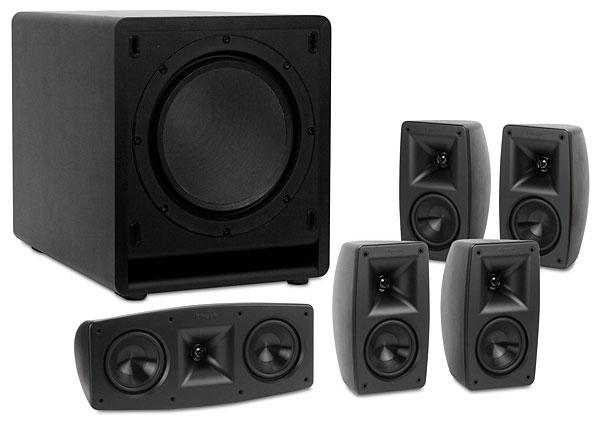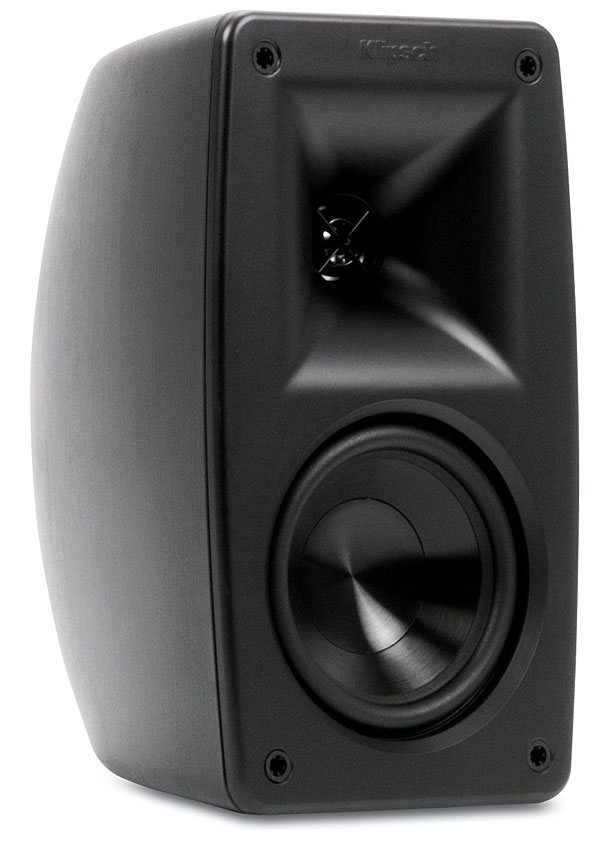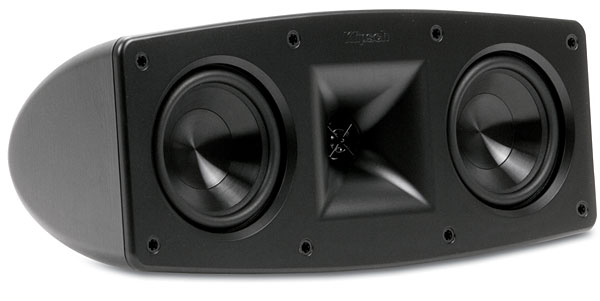Klipsch Quintet Speaker System

Compact satellite/subwoofer sets are often affordable, mate well with budget receivers, allow more speaker-placement width than soundbars, lend themselves to wall mounting—and best of all, they don’t hog the room, even if you place them on stands (which would usually produce the best sonic results). What Justice Anthony Kennedy’s swing vote is to the Supreme Court, the spouse acceptance factor is to loudspeaker genres, and the elegant compactness of a sat/sub set just may be the tiebreaker, the factor that makes the difference between having or not having a surround system. Sat/sub sets continue to be the most underrated product category in home theater.
Klipsch’s Quintet is one of the category’s all-time best sellers. One of the few sat/sub sets to incorporate horn-loaded tweeters, it’s been quite successful at coaxing consumers to adopt the sat/sub philosophy. The latest Quintet is the fifth generation—which incidentally has no other model name or number. It’s the first “all-out redesign” of the line in its 15-year life span. And it’s got something special, which Klipsch refers to as AcoustaComp.
What Is AcoustComp?
AcoustaComp is a fiber-reinforced composite material molded under high pressure. When I first saw the new Quintet at the 2013 Consumer Electronics Show,
I also heard it described as a “forged stone polymer.” Klipsch describes it as “naturally dense, rigid, and acoustically inert,
with a uniquely exquisite finish.”
It is used to mold the horns in pro-level speakers by Klipsch
and other manufacturers, including the Klipsch MCM Grand, described as “the first and only fully horn-loaded THX-approved four-way cinema system.” Because the Quintet enclosure is not limited by the procedures and economics of wood fiber-based cabinetmaking, it is able to dispense with the parallel walls of inexpensive fiberboard speakers. The resulting curvy shape minimizes standing waves from forming inside. The stone-like density also defeats cabinet resonance. Knock on it, and you’ll hear a tight thunk, not the resonance usually associated with a hollow box.

Behind their fabric-covered grilles, the satellite and center feature a 0.75-inch aluminum diaphragm compression driver with a Tractrix horn. The new 90 x 90-degree horn has wider vertical dispersion than the old 90 x 40-degree horn. Klipsch says this expands the sweet spot; in practice, I found that it also afforded greater spaciousness, especially in height. A Klipsch hallmark with decades of refinement, the horn-loaded tweeter improves output sensitivity and dynamic range and reduces reflections from room surfaces. Benefits in this case are plainly audible—you don’t need golden ears to tell the difference. The tweeter also incorporates what Klipsch calls a linear travel suspension, a flexible surround separate from the diaphragm itself that allows it to move more like a piston.
Mating with the tweeter is a 3.5-inch woofer with an injection-molded graphite (IMG) cone. It has also been redesigned with a new basket that better ventilates the larger voice coil. The profile of the cone has been optimized to prevent twisting at full excursion. In other words, when moving as far as it can go, the cone maintains its shape. The first-order crossover is also new and has fewer parts for greater electrical efficiency. It is similar in both the satellite and center speakers, presumably for closer timbre matching. Rated sensitivity is 91 decibels for the satellite, on the high side of average; and 94 dB for the center, which should make the horizontal dual-woofer speaker even easier to drive.
On the back of the speaker are some interesting features. You’ll find both a threaded insert and a keyhole mount, concentrically arranged, with the insert ingeniously built into the keyhole. When I first saw the deeply recessed binding posts, I dreaded having to get cables into them. But the recess was cone-shaped, narrowing as the wire tip approaches the binding post hole, and actually guided the wire into the post—so wiring the speakers wasn’t as hard as I thought it would be. I used 12-gauge zip cord, but 16 probably would have been a better fit. Tinned wire ends might help. A quick experiment confirmed that the posts and recesses would also accommodate pin connectors.

The complementary subwoofers, available separately, do have individual model numbers. The 12-inch version is the SW-112, and the 10-inch, reviewed here, is the SW-110. The vented enclosure, sporting a slot-shaped port on the front, is constructed of standard fiberboard with a matte vinyl finish. The driver’s cone is woven fiberglass, backed up in the SW-110 by a hybrid BASH amp, which combines a switching, tracking power supply with Class AB output. It is rated at 200 RMS and 450 watts “dynamic power.” Line- and speaker-level inputs are provided (no outputs).
The back panel also includes a proprietary WA port to accommodate the WA-2 wireless subwoofer kit, which I didn’t have a chance to try. A $129 option, it’s not exactly cheap, but it might be worthwhile if the optimum position for the sub is not within cabling distance of the receiver. Given that the sub has to mate with small satellites at a high crossover, say 120 to 150 hertz, it will have to stay close to the front speakers to provide a good blend. I’m guessing that if you can run speaker cables to the sats and center, you can run a line-level interconnect to the sub.





























































